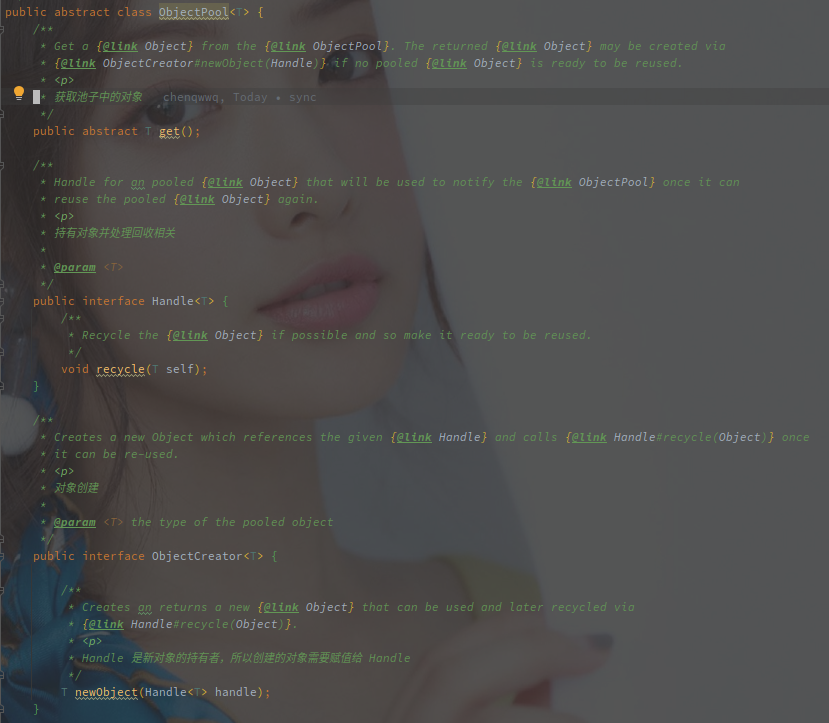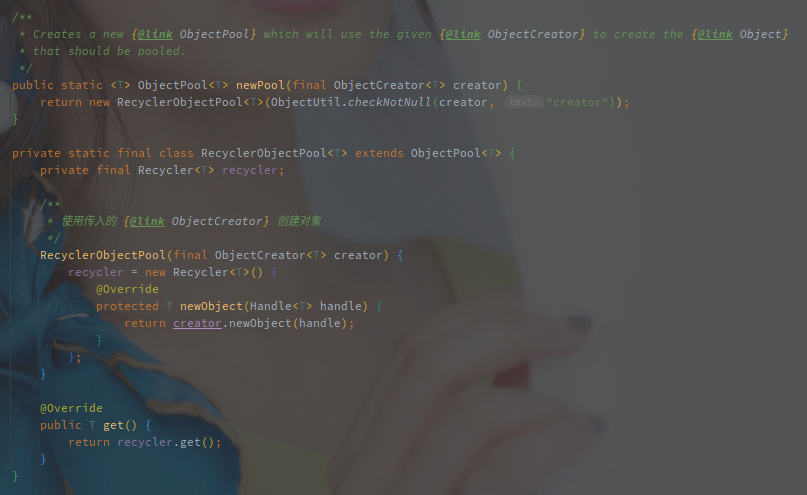Recycler
[TOC]
概述
对象池和连接池之类的一样都是享元模式的实现,减少对象的重复创建和回收,减少 GC 压力。
Netty 针对于对象池有一个轻量级的实现 ObejctPool,其基本实现就是 Recycler。
除了 Netty,Apache Common Pool2 也是一种常用的对象池实现。
和 Recycler 不同,Apache 的对象池采用的是阻塞队列来保证并发安全(底层还是 AQS 那一套。
基本使用如下:
public class Main {
static class Obj {
static AtomicInteger idGen = new AtomicInteger();
int id;
ObjectPool.Handle<Obj> handle;
public Obj(ObjectPool.Handle<Obj> handle) {
this.id = Obj.idGen.incrementAndGet();
this.handle = handle;
}
@Override
public String toString() {
return "Obj{" +
"id=" + id +
'}';
}
// 这个方法实现有点膈应
// 需要通过 handle 来让对象重新回到池子中
public void recycle() {
handle.recycle(this);
}
}
public static void main(String[] args) {
ObjectPool<Obj> objPool = ObjectPool.newPool(new ObjectPool.ObjectCreator<Obj>() {
@Override
public Obj newObject(ObjectPool.Handle<Obj> handle) {
return new Obj(handle);
}
});
final Obj o1 = objPool.get();
o1.recycle();
final Obj o2 = objPool.get();
System.out.println(o1);
System.out.println(o2);
System.out.println(o1 == o2);
}
}
// 输出如下:
// Obj{id=1}
// Obj{id=1}
// true
使用的时候不推荐直接实现 Recycler,而是采用 ObjectPool.newPool() 去创建。
对象的回收方法需要通过 Handle。
对于对象池的简单思考
对象池和线程池一样,由池这个概念持有全部的对象,对象池持有所有的对象,线程池持有所有的线程,在使用时从池子中获取,使用完毕归还给池子。(所以对于对象池的接口,甚至可以只有简单的 Get / Put 方法。
除了获取和归还的方法之外,还有对象何时创建以及多线程并发的问题。
对于何时创建,一般来说是在获取不到的时候,或者创建池子的时候先初始化 n 个对象供急用(例如线程池可以实现创建 coreSize 个线程)。
和线程池类似,对象池也有一个最大容量的上限,或者在增加一个核心容量。
多线程并发的问题,简单一点可以使用 synchronized 直接保证,线程池中使用了 BlockQueue,底层相当于是使用 AQS 保证的并发安全。
对于池中的对象来说,没有必要标记它属于哪个池子,获取之后应该删除所有池子对于该对象的引用,如果不归还对象,则由 GC 带走。(个人感觉,对于已经被获取的对象,池子不应该对其生命周期做任何限制。
ObjectPool
Netty 实现的 ObjectPool 中定义了如下三种对象:
- ObjectPool - 最上层的对象池,负责持有所有对象并对获取方法进行调度
- ObjectCreator - 对象创建
- Handle - 持有对象的引用,也负责对对象进行回收

并且默认使用 Recycler 作为基础实现的 RecyclerObjectPool 类:

RecyclerObjectPool 直接创建了 Recycle 作为其内部工具,构造函数中传入一个 ObjectCreator 就可以创建一个对象池。
以下从获取和归还两个角度分析 Recycler 的具体实现。
Recycler#get 获取对象
以下是 Recycler#get 的方法源码:
@SuppressWarnings("unchecked")
public final T get() {
// 配置是否为空池
if (maxCapacityPerThread == 0) {
return newObject((Handle<T>) NOOP_HANDLE);
}
// 由 FastThreadLocal 持有 Stack 对象
// 每个线程一个 Stack,直接快进到 initValue 方法
Stack<T> stack = threadLocal.get();
// 从中弹出一个对象
DefaultHandle<T> handle = stack.pop();
// 没有返回一个对象
if (handle == null) {
// 重新创建
handle = stack.newHandle();
handle.value = newObject(handle);
}
// Handle 好像是为了持有该值
return (T) handle.value;
}
对象的保存并不是在一个统一的集合里面,而是通过 FastThreadLocal 使每个线程都持有自己的对象。
ThreadLocal 就是空间换时间,减少锁的消耗。
Stack 并不是 JDK 中的实现,而是 Recycler 中通过数组模拟的,获取到 Stack 之后,就尝试弹出(获取)对象,获取失败则创建。
Stack#pop 弹出对象
DefaultHandle<T> pop() {
// size 表示当前池子中对象的个数
int size = this.size;
// 当前并没有对象未被使用
if (size == 0) {
// 尝试回收对象
if (!scavenge()) {
return null;
}
size = this.size;
// 尝试回收之后仍然小于0,表示实在没有对象了
if (size <= 0) {
// double check, avoid races
return null;
}
}
// 分配空余对象
// 这里必须先 size --
// size -- 就已经占据了一个对象,如果先获取对象,那么对象可能会被多次获取
size--;
// 分配最后一个对象
DefaultHandle ret = elements[size];
elements[size] = null;
// 修改当前对象数目
this.size = size;
// lastRecycledId 表示归属
if (ret.lastRecycledId != ret.recycleId) {
throw new IllegalStateException("recycled multiple times");
}
ret.recycleId = 0;
ret.lastRecycledId = 0;
return ret;
}
弹出对象就是从底层数组中获取对象,在获取之前如果发现没有对象,尝试从 WeakOrderQueue 中回收一波。
Stack#scavengeSome 收集对象
Recycler 的无锁化设计重点之一就是和 Stack 所绑定线程不同的线程归还对象时,并不能直接添加到底层的数组,而是添加到 Stack 的 WeakOrderQueue 链表中(下文会说到,剧透下。
以下是 Stack#scavengeSome 的源码实现:
/**
* 从 {@link WeakOrderQueue} 中回收部分数据
*/
private boolean scavengeSome() {
WeakOrderQueue prev;
// 设置当前游标
WeakOrderQueue cursor = this.cursor;
if (cursor == null) {
prev = null;
cursor = head;
if (cursor == null) {
return false;
}
} else {
prev = this.prev;
}
boolean success = false;
do {
if (cursor.transfer(this)) {
success = true;
break;
}
WeakOrderQueue next = cursor.getNext();
if (cursor.get() == null) {
// If the thread associated with the queue is gone, unlink it, after
// performing a volatile read to confirm there is no data left to collect.
// We never unlink the first queue, as we don't want to synchronize on updating the head.
if (cursor.hasFinalData()) {
for (; ; ) {
if (cursor.transfer(this)) {
success = true;
} else {
break;
}
}
}
if (prev != null) {
// Ensure we reclaim all space before dropping the WeakOrderQueue to be GC'ed.
cursor.reclaimAllSpaceAndUnlink();
prev.setNext(next);
}
} else {
prev = cursor;
}
cursor = next;
} while (cursor != null && !success);
this.prev = prev;
this.cursor = cursor;
return success;
}
就是从 WeakOrderQueue 组成的链表中回收对象。
归还对象
归还对象是需要区分对象绑定的 Stack 是否由当前线程负责。
以下是 DefaultHandle#recycle 的源码实现:
/**
* 释放对象使用
*/
@Override
public void recycle(Object object) {
if (object != value) {
throw new IllegalArgumentException("object does not belong to handle");
}
//
// 获取对象从属的 Stack
Stack<?> stack = this.stack;
if (lastRecycledId != recycleId || stack == null) {
throw new IllegalStateException("recycled already");
}
// 将对象重新塞入 Stack
stack.push(this);
}
从 Handle 中取出绑定的 Stack,之后就是通过 push 归还对象,以下是 Stack#push 的实现:
void push(DefaultHandle<?> item) {
// 获取当前线程
Thread currentThread = Thread.currentThread();
// 判断是否是当前线程
// important: 可以存在一个线程取出之后给别的线程使用的情况
if (threadRef.get() == currentThread) {
// The current Thread is the thread that belongs to the Stack, we can try to push the object now.
pushNow(item);
} else {
// The current Thread is not the one that belongs to the Stack
// (or the Thread that belonged to the Stack was collected already), we need to signal that the push
// happens later.
pushLater(item, currentThread);
}
}
根据是否为当前线程绑定的 Stack,区分立即归还和延迟归还。
立即归还的实现如下:
private void pushNow(DefaultHandle<?> item) {
if ((item.recycleId | item.lastRecycledId) != 0) {
throw new IllegalStateException("recycled already");
}
// 配置归属的线程Id
item.recycleId = item.lastRecycledId = OWN_THREAD_ID;
int size = this.size;
// 对象池满了
// 在 size 小于 maxCapacity 的时候,尝试 dropHandle
if (size >= maxCapacity || dropHandle(item)) {
// Hit the maximum capacity or should drop - drop the possibly youngest object.
return;
}
// 到这里之后,size 肯定小于 maxCapacity
// 存放对象的数组满了,就扩容
if (size == elements.length) {
size <<= 1;
if (size > maxCapacity) {
elements = Arrays.copyOf(elements, min(size << 1, maxCapacity));
}
}
// 放入数组
elements[size] = item;
this.size = size + 1;
}
如果池子满了直接淘汰对象,如果池子没满则将对象塞入底层数组,数组长度不够则进行扩容。
其中 dropHandle 方法是用来确定对象回收的比例,在 Netty 的实现中并不是所有的对象都会被重复使用,会通过一定的比例淘汰掉一部分的对象。
再来是延迟归还的情况:
private void pushLater(DefaultHandle<?> item, Thread thread) {
if (maxDelayedQueues == 0) {
// We don't support recycling across threads and should just drop the item on the floor.
return;
}
// we don't want to have a ref to the queue as the value in our weak map
// so we null it out; to ensure there are no races with restoring it later
// we impose a memory ordering here (no-op on x86)
// 每个线程还绑定了一个 Stack -> WeakOrderQueue 的映射
// 每个线程独立的 Map
Map<Stack<?>, WeakOrderQueue> delayedRecycled = DELAYED_RECYCLED.get();
// 每个线程往同一个 Stack 延迟归还的时候,都是放到不同的 WeakOrderQueue 中。
WeakOrderQueue queue = delayedRecycled.get(this);
if (queue == null) {
if (delayedRecycled.size() >= maxDelayedQueues) {
// Add a dummy queue so we know we should drop the object
// 在下面就可以看到 如果是 DUMMY 队列的话会直接抛弃
delayedRecycled.put(this, WeakOrderQueue.DUMMY);
return;
}
// Check if we already reached the maximum number of delayed queues and if we can allocate at all.
if ((queue = newWeakOrderQueue(thread)) == null) {
// drop object
return;
}
delayedRecycled.put(this, queue);
} else if (queue == WeakOrderQueue.DUMMY) {
// drop object
return;
}
queue.add(item);
}
延迟归还发生在归还线程并不是对象归属线程的时候。
此时并不是存放到线程对应的 Stack 中,而是当前线程的 WeakOrderQueue 中(使用目标线程的 Stack 绑定。
随记
Stack 是一个用数组模拟的栈,每一个线程都会绑定一个 Stack 对象,使用 FastThreadLocal 作绑定。
所有的对象都被包装为 DefaultHandle,DefaultHandle 是 Recycler 的内部类,它的 recycle 方法实现了对象重入 Stack 的逻辑。
理论上,因为用线程做了对象的区分,所以应该由获取的线程去释放对象的使用,但是可能会出现引用逃逸的情况,当前线程可能将对象传递给别的线程,此时释放就需要由别的线程完成。
多线程归还对象(将对象添加到 Stack 底层的数组中,此时就需要上锁保证其并发安全性。
Netty 做了无锁化处理,即只有 Stack 的线程才可以处理 Stack 中的数组(添加或者删除。
所以由别的线程归还对象时,并不是直接归还到该 Stack 中,而是保存在 WeakOrderQueue 中,使用另外一个 FastThreadLocal 保存了 Stack 和 WeakOrderQueue(持有着对象)的映射关系。
一个 Stack 中不同的 Thread 会创建不同的 WeakOrderQueue,然后添加当前线程所释放的对象。
获取对象的流程:
- 获取当前线程绑定的 Stack(通过 FastThreadLocal
- 获取 Stack 数组中的对象,如果不存在则尝试从 WeakOrderQueue 中回收(由其他线程所释放的对象,WeakOrderQueue 中使用 Link 保存对象
- 如果还没有获取到对象,则直接使用 newObject 创建对象(该方法需要自定义
对象释放的流程:(对象的释放由于 DefaultHandle 触发,在创建的时候就会传递一个 Handle 进参数,但是真实的逻辑是在 Stack 中
- 判断当前线程是否是 Stack 绑定的 Thread
- 如果是则直接添加到数组(中间还有扩容以及部分丢弃的逻辑
- 如果不是则尝试添加到当前 Stack 的 WeakOrderQueue